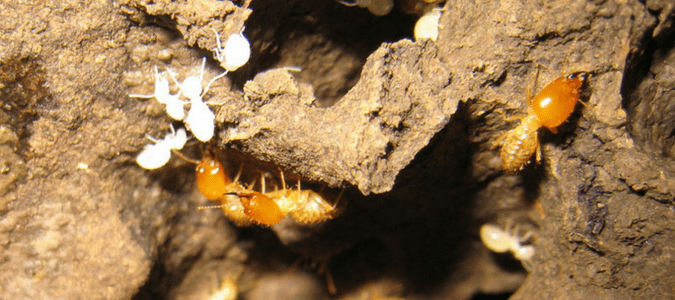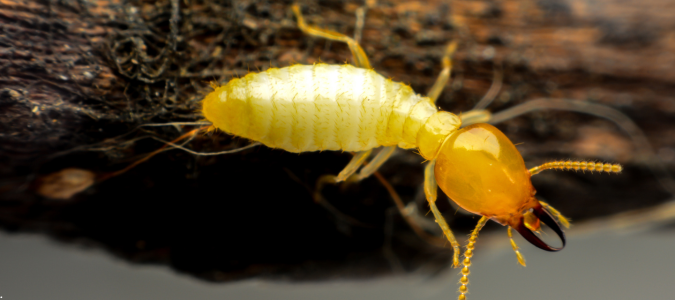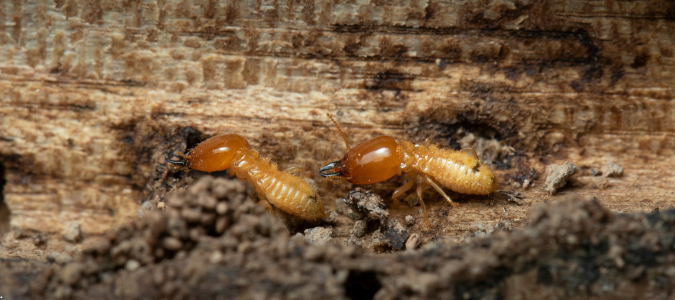Key Takeaways
Early termite signs are easier to spot than termites themselves—watch for mud tubes, damaged or hollow-sounding wood and discarded wings. Quick detection helps prevent expensive structural damage.
As a homeowner, you spend time and effort keeping up with the maintenance of your home. Unfortunately, there’s a pest that can quietly cause extensive damage: termites.
Termites create big problems wherever they go. They’re responsible for costly and extensive damage to homes all over the country, but in Texas, they’re even more of an issue because of our climate.
While termites prefer to stay hidden, they leave behind evidence of their presence that is easier to spot if you know what to look for. Most homeowners find signs of termites before they ever see a termite themselves. Noticing the signs of termites can help you catch termites early, before they cause extensive damage to your home.
Things to Look for During a Basic Inspection
It’s important to keep a watchful eye for signs of termites, but the best way to protect your home from termite damage is by calling in a pest control pro. A professional can help you treat these pests before they cause extensive damage.
Using everyday tools like a flashlight and a screwdriver, you can do a quick check around your home for termites. Look for these telltale signs:
Outside Your Home
- Mud tubes on your foundation or walls
- Check any wood-to-soil contact
Inside Your Home
- Termite droppings (frass) that look like sawdust
- Discolored, blistering or hollow-sounding wood
- Discarded wings near doors or windows
- Peeling paint or warped trim
Let’s take a closer look at each of these signs.
Outside Your Home
Mud Tubes on Your Walls or Foundation
Mud tubes are a highway system for termites, enabling them to access wood in your home from the soil where they live. Subterranean termites are well known for building these intricate tubes because they need ample moisture and humidity to survive. They make their homes in the soil and use mud tubes to reach their food supply, which could be the inside of your walls.
You might find these tubes running along your foundation or at any point where soil meets wood joints. Your garage and crawlspaces are excellent candidates for these tubes, so take your flashlight with you and see what you find. Uncovering one can be a clear sign of termite activity. If you spot a mud tube around your home, it’s time to contact a pest control professional.
Check Any Wood-to-Soil Contact
Any direct wood-to-soil contact can allow termites to enter your home. This includes deck supports, fence posts and even piles of wood stored close to the house.
This is when you can use a screwdriver to gently poke at any suspicious or discolored wood. If it sinks or crumbles under your pressure, that’s a sign it’s previously been dinner for a termite colony.
Inside Your Home
Termite Droppings (Frass)
Termite droppings, or frass, are one of the more challenging signs to spot. If you do manage to find it, you likely have drywood termites.
Drywood termites don’t need contact with soil and live among the wood they feed on, so you’re much more likely to find visible signs of their presence, like frass.
Subterranean termites are generally more common in Central Texas than drywood termites. This means you’re much more likely to find mud tubes than frass.
Discarded Wings Near Doors or Windows
Finding discarded wings is one of the more telltale signs of a termite colony. A group of termites, known as swarmers, grows wings to help find mates. When the colony reaches maturity, the swarmers fly out of the mud tubes to find a mate. Once they find a mate, they shed their wings, so it’s common for homeowners to find piles of discarded wings in one spot.
If you notice small, delicate wings clustered together around your home, it’s best to call in a pest control pro.
Discolored, Blistering or Hollow-Sounding Wood
Most homeowners expect the first sign of termites to be discolored or damaged wood. However, termites are sneaky. They eat the wood from the inside out, so seeing external damage to the wood in your home isn’t necessarily due to termites.
It’s more important to pay attention to subtle changes, like blistering or peeling, or whether the wood in your home sounds hollow when you tap it.
Peeling Paint or Warped Trim
Finding peeling paint or warped trim can sometimes look like water damage, but it can signal termite activity. As termites feed on wood from the inside out, they leave behind moisture that causes paint to blister and wood to swell or bend.
You may notice these issues along baseboards, window frames or door casings. If the wood feels soft when you press on it or it sounds hollow, it’s time to call in a pest control pro to inspect your home.
What Our Customers Say
“ABC has been our pest/termite control company for almost a decade. Even used their handyman service and tree service. Wouldn’t hesitate to call upon them for any service they offer.”
— Rol C.
Can Termites Suddenly Appear?
Many homeowners think termite infestations happen out of the blue. Homeowners often notice termites when they are “swarming”. This is when winged termites emerge from the colony to find mates and start new colonies.
Swarming doesn’t mean that termites are suddenly attacking your home. Simply put, it means there is a termite colony nearby.
Termite swarms involve the reproductive cycle of the colony’s lifespan. Once a colony has everything it needs, it produces adults called “swarmers.” These termites have one goal: to find a mate and establish a new colony in a new location. Swarmers are also the reason you might see discarded wings around exit and entry points in your home.
When Do Termites Swarm?
Swarming is more common when the weather is warm and the humidity is high. In Texas, the swarming termite season starts in early spring. The exact timing will depend on the species and colony.
Swarms are also brief, usually less than an hour long. If you notice termites swarming near your home, it’s best to call in a pest control pro to handle them.
What Should You Not Do With Termites?
If you’ve found early signs of termites, you likely feel worried and frustrated, and want to get rid of them as quickly as possible.
Many homeowners’ first instinct is to use insecticide or tear apart their home to find the infestation. However, disturbing their environment can cause them to relocate to another part of your home. It’s best to leave termites alone and let professionals handle treatment.
You don’t want to use over-the-counter insecticides as a long-term solution. They’re not effective at tackling the problem at its source. Sprays might take care of a few termites, but the majority of the colony will remain unaffected. Then, you’ll be playing whack-a-mole with your termite problem rather than tackling it head-on.
Frequently Asked Questions About Termites
How do I tell the difference between termites and water damage?
How fast can termites cause damage?
When do termites swarm in San Antonio?
Can I manage termites on my own?
How can I help prevent termites in the future?
Contact ABC Home & Commercial Services at the First Sign of Termites
If you recognize any of these signs on your property, our pest control experts can provide an effective solution. Contact ABC Home & Commercial Services to take back your home from a termite colony.




